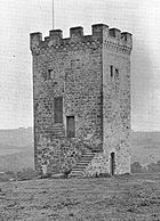
Caldwell, East Renfrewshire
Encyclopedia
Caldwell is a mansion and old estate with the remains of a castle nearby. These lands lie close to the Lugton Water
and the villages of Uplawmoor
in East Renfrewshire
and Lugton
in East Ayrshire
.
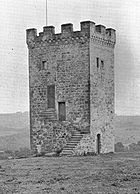
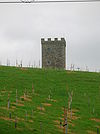 The Caldwell Tower (NS 4223 5512), stands on a mound, and is a small, free-standing tower of probable 16th century origin. Square on plan, of good coursed rubble, it contains three stories beneath the parapet. This is carried on two courses of individual corbels. The crenellations seem to have been renewed.
The Caldwell Tower (NS 4223 5512), stands on a mound, and is a small, free-standing tower of probable 16th century origin. Square on plan, of good coursed rubble, it contains three stories beneath the parapet. This is carried on two courses of individual corbels. The crenellations seem to have been renewed.
The door at ground floor level is in the west wall and admits to a vaulted basement, which does not communicate with the upper stories. The first floor, also vaulted, is reached via a modern forestair. The flooring above has been altered. The windows are small, and there are signs of built-up gun-loops in the walling. The fabric throughout is in fair condition. This tower is thought to have been part of the courtyard-type Caldwell Castle. Rubble, possibly from demolished ancillary buildings has been noted at the site.
Ainslie's map of 1775 indicates a 'pigeon house' or 'doocot' at the position of the tower, indicating a later use of this castle remnant. Some indications of the tower being a focal point of the pleasure gardens, linked to a belvedere
have been suggested.

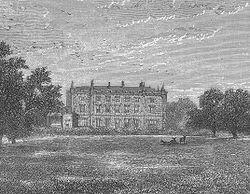
even before 1328 and his son Gilchrist Mure of Cowdams acquired the lands and castle of Caldwell through marriage to the heiress of Caldwell of that Ilk. John Mure was designed 'of Caldwell' in 1409. In about 1450 Ramshead, Biggart, and Little Highgate (in the Barony of Giffen
) lands were granted to the family. The estate of Little Caldwell remained with the Caldwells of that Ilk until the late 17th century and was added later to the larger estate by purchase. The most ancient seat of the Mure family was Polkelly, near Kilmarnock.
When King David II
was taken prisoner at the battle of Nevill's Cross, Sir William Mure of Caldwell was appointed as one of the twelve nobles who negotiated the terms for his release. He was held as hostage until the ransom was paid in full.
William Mure was a Baron of the Scottish Exchequer and factor for the Scottish estates of the Earl of Bute. The Mure family were connected through marriage with Oliver Cromwell
, the Lord Protector.
William and Alexander Cuninghame of Aiket castle were accused of the murder of Sir John Muir of Caldwell on the lands of Bordland in 1570, but were acquitted. Alexander was involved in the murder of Hugh, 4th Earl of Eglinton
at the Annick Ford in Stewarton
and was murdered in turn as a result, whilst the father was poisoned by his own wife!
Colonel William Mure the laird in the early 20th century, was married to the Honorable Lady Georgiana Montgomerie of Eglinton Castle
, eldest daughter of the Earl of Eglinton and Winton.
The burial vault of the Mures of Caldwell is in Neilston
church, under the gothic window at the north end of the church. Only those Mures who were in the direct line of succession were permitted to be buried here. The family's patronage of Neilston church was later disposed to the Mures of Glanderston.
designed house was built by his son, William 'Baron Mure' about 200 yards lower down from the original. Caldwell is the last in a series of early experimental houses in the castle style which began in England with Ugbrooke
House and in Scotland with Mellerstain House
in Berwickshire. The house is protected as a Category A listed building.
In 1799, Jean Hunter Mure, writing from Caldwell, records that Mr Mure is at present in the very agony of making a new garden on the Brandy Hill behind the stables and offices. He has converted the old house into stables and means next year to take away the offices entirely which will make an immense improvement to the place for at present they are not a beautiful ornament.
Caldwell House was the Mure family home until 1909. In 1927 Govan District Health Board converted the building into a hospital for mentally handicapped children which operated until 1985. Alterations, including the removal of the main stair to accommodate a lift shaft, led to a general decline in the state of the interior. External changes also occurred. These included fire escapes and additional boiler room and laundry buildings attached to the house. In 1987 the estate was sold off in lots by the Secretary of State. In 1995 a serious fire caused further internal deterioration and the loss of most of the roof. The building has been on the Scottish Civic Trust's Buildings at Risk register for some years. In 2006 attempts to secure restoration of the building through a Council led restoration project were initiated.
The name 'Blackstands' may derive from 'Blackston' as the Mure's were the Lairds of Blackston. Nether Ramshead was a Mure property from early times, being recorded as such in 1617, together with Cawdamis (near Symington), Hiegaittis, Knokewart and Dunyflat.
Sir William Cunninghame of Cunninghamhead
married Elizabeth Nicolson in 1619 and had a daughter Barbara, who married William Mure of Caldwell. She suffered greatly for her presbyterian beliefs in 'the bad times' of the 'Highland Host', as did her father. Waterlands is recorded since 1603 as belonging to John Montgomery of Achenbothy and passed in to the hands of the Caldwell estate before becoming privately owned.
Duniflett, now Duniflatt was part of the estate in 1604, up until at least the 1880s. Muirtoun is marked by Pont, but seems to have been covered by the extended plantations established by Lieutenant-Colonel William Mure.
was rifled by John Mure, Laird of Caldwell during the earliest days of what was to became the Scottish Reformation. The laird besieged with artillery and took the castle, he then made off with the bishop's principal goods and chattels as fair and legitimate booty. James V
was a child still and the Duke of Albany
was the regent. He was made to answer to the Lords of Council, found guilty and was forced to pay reparation. His actions reflected the people's growing unease with the power and wealth of the church.
s took place under Colonel Wallace which ended in disaster at the Battle of Pentland
. William Mure of Caldwell, the Laird of Blackston in Renfrewshire, was the leader of a group of about fifty who hoped to join up, but they were prevented by the presence of the King's troops. William, despite assisting the King's troops in prosecuting the others in his group, lost his lands to General Dalziel. The family regained the property after the overthrow of King James VII in 1688.
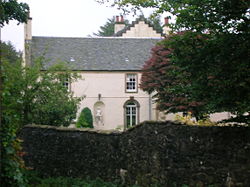
 This property (Map ref: NS 4141 5504), sitting on the B775 Gleniffer Road, was also known as Little or Wester Caldwell; it sits in the hamlet or fram town of Hall, next to Hall Farm. In the 17th century it returned a Member to the Scottish Parliament, the 'Guidman of that Ilk,' the title referring to a person who held land from a Laird. The Laird sent the tenant of the Hall of Caldwell to Parliament in his place and paid his expenses of £13 6s 8d. In 1909 Colonel Mure extended the hall by adding a commodius 'modern' addition. In 1927 the architects Allan Stevenson, Mair & Cassells, were responsible for further addition, alterations and a new garden wall.
This property (Map ref: NS 4141 5504), sitting on the B775 Gleniffer Road, was also known as Little or Wester Caldwell; it sits in the hamlet or fram town of Hall, next to Hall Farm. In the 17th century it returned a Member to the Scottish Parliament, the 'Guidman of that Ilk,' the title referring to a person who held land from a Laird. The Laird sent the tenant of the Hall of Caldwell to Parliament in his place and paid his expenses of £13 6s 8d. In 1909 Colonel Mure extended the hall by adding a commodius 'modern' addition. In 1927 the architects Allan Stevenson, Mair & Cassells, were responsible for further addition, alterations and a new garden wall.
Previous to the Covenanting
times the open green in front of the old Hall of Caldwell was a favourite place for dance gatherings on summer Sunday evenings, with people coming from Neilston, Lochwinnoch, and Beith.
In the 1870's a Robert Montgomerie, who had occupied the farm of Bruchag on Bute left for Hall of Caldwell and later moved to Lessnessock. John Cuninghame Montgomerie of Dalmore House
was a relative.
ran from Caldwell House to the old Lugton Inn (now demolished), however a search by owners in the cellars did not revealed any signs of a hidden passage.
Like many of the other Cunninghame lairds, the Mures had a townhouse in Irvine
.
Mr. Mure of Caldwell attended the Eglinton Tournament of 1839.
A station called Caldwell
existed near Uplawmoor. It opened in 1871 and was renamed to Uplawmoor upon the closure of the station with the same name on the Lanarkshire and Ayrshire Railway
in 1962. In 1966 Caldwell was renamed 'Tannochbrae' and dressed with period detail for one day on the 11th October to allow the filming of an episode of Dr Finlay's Casebook. 'J36' 0-6-0 No. 65345 was provided for the filming, together with two Caledonian coaches.
The Lochlibo Road runs through the strath and this was the old turnpike, completed from Glasgow by Lugton
, to Kilmarnock, Irvine and Ayr in 1820 at the cost of £18,000.
The ten acre Halket Loch
once lay near the toll road fron Duniflat between the various Halket Farms, Lochridgehills, and Craighead Law.
Lugton Water
The Lugton Water, the largest tributary of the River Garnock, runs from Loch Libo in Uplawmoor, through Lugton and the parishes of Neilston, Beith, Dunlop, Stewarton and Kilwinning...
and the villages of Uplawmoor
Uplawmoor
Uplawmoor is a village in East Renfrewshire, Scotland. Population 590 .Historic Uplawmoor, associated for centuries with the Barony of Caldwell and the Mure family, is still a vibrant community today, although now bereft of many of the services once to be found there...
in East Renfrewshire
East Renfrewshire
East Renfrewshire is one of 32 council areas of Scotland. Until 1975 it formed part of the county of Renfrewshire for local government purposes along with the modern council areas of Renfrewshire and Inverclyde...
and Lugton
Lugton
Lugton is a small village or hamlet in East Ayrshire, Scotland with a population of 80 people. The A736 road runs through on its way from Glasgow, to the north, to Irvine in North Ayrshire. Uplawmoor is the first settlement on this 'Lochlibo Road' to the north and Burnhouse is to the south...
in East Ayrshire
East Ayrshire
East Ayrshire is one of 32 council areas of Scotland. It borders on to North Ayrshire, East Renfrewshire, South Lanarkshire, South Ayrshire and Dumfries and Galloway...
.
Caldwell Castle and tower


The door at ground floor level is in the west wall and admits to a vaulted basement, which does not communicate with the upper stories. The first floor, also vaulted, is reached via a modern forestair. The flooring above has been altered. The windows are small, and there are signs of built-up gun-loops in the walling. The fabric throughout is in fair condition. This tower is thought to have been part of the courtyard-type Caldwell Castle. Rubble, possibly from demolished ancillary buildings has been noted at the site.
Ainslie's map of 1775 indicates a 'pigeon house' or 'doocot' at the position of the tower, indicating a later use of this castle remnant. Some indications of the tower being a focal point of the pleasure gardens, linked to a belvedere
Belvedere (structure)
Belvedere is an architectural term adopted from Italian , which refers to any architectural structure sited to take advantage of such a view. A belvedere may be built in the upper part of a building so as to command a fine view...
have been suggested.
The Mures, Caldwell House and the estate


The Mures
In 1294 the estate of Caldwell had boundaries which marched with the Steward's forest of Fereneze. Sir Reginald More or Mure, of Abercorn, held the lands of Cowdams near SymingtonSymington
-People:*J. Fife Symington Jr. , American diplomat*Fife Symington III , American politician; Governor of Arizona*Gaye Symington , American politician, Speaker of the Vermont House of Representatives...
even before 1328 and his son Gilchrist Mure of Cowdams acquired the lands and castle of Caldwell through marriage to the heiress of Caldwell of that Ilk. John Mure was designed 'of Caldwell' in 1409. In about 1450 Ramshead, Biggart, and Little Highgate (in the Barony of Giffen
Barony and Castle of Giffen
The Barony of Giffen and its associated 15th-century castle were in the parish of Beith in the former District of Cunninghame, now North Ayrshire. The site may be spelled Giffen or Giffin and lay within the Lordship of Giffin, which included the Baronies of Giffen, Trearne, Hessilhead, Broadstone,...
) lands were granted to the family. The estate of Little Caldwell remained with the Caldwells of that Ilk until the late 17th century and was added later to the larger estate by purchase. The most ancient seat of the Mure family was Polkelly, near Kilmarnock.
When King David II
David II of Scotland
David II was King of Scots from 7 June 1329 until his death.-Early life:...
was taken prisoner at the battle of Nevill's Cross, Sir William Mure of Caldwell was appointed as one of the twelve nobles who negotiated the terms for his release. He was held as hostage until the ransom was paid in full.
William Mure was a Baron of the Scottish Exchequer and factor for the Scottish estates of the Earl of Bute. The Mure family were connected through marriage with Oliver Cromwell
Oliver Cromwell
Oliver Cromwell was an English military and political leader who overthrew the English monarchy and temporarily turned England into a republican Commonwealth, and served as Lord Protector of England, Scotland, and Ireland....
, the Lord Protector.
William and Alexander Cuninghame of Aiket castle were accused of the murder of Sir John Muir of Caldwell on the lands of Bordland in 1570, but were acquitted. Alexander was involved in the murder of Hugh, 4th Earl of Eglinton
Earl of Eglinton
Earl of Eglinton is a title in the Peerage of Scotland.Some authorities spell the title: Earl of Eglintoun In 1859 the thirteenth Earl of Eglinton, Archibald Montgomerie, was also created Earl of Winton in the Peerage of the United Kingdom, which gave him an automatic seat in the House of Lords,...
at the Annick Ford in Stewarton
Stewarton
Stewarton is a town in East Ayrshire, Scotland. In comparison to the neighbouring towns of Kilmaurs, Fenwick, Dunlop and Lugton, it is a relatively large town, with a population of over 6,500. It is 300 feet above sea level.Groome, Francis H. . Ordnance Gazetteer of Scotland. Pub. Caxton. London....
and was murdered in turn as a result, whilst the father was poisoned by his own wife!
Colonel William Mure the laird in the early 20th century, was married to the Honorable Lady Georgiana Montgomerie of Eglinton Castle
Eglinton Castle
Eglinton Castle was a large Gothic castellated mansion in Kilwinning, North Ayrshire, Scotland.-The castle :The ancient seat of the Earls of Eglinton, it is located just south of the town of Kilwinning...
, eldest daughter of the Earl of Eglinton and Winton.
The burial vault of the Mures of Caldwell is in Neilston
Neilston
Neilston is a village and parish in East Renfrewshire set in the west central Lowlands of Scotland. It lies in the Levern Valley, southwest of Barrhead, south of Paisley, and south-southwest of Renfrew, at the southwestern fringe of the Greater Glasgow conurbation...
church, under the gothic window at the north end of the church. Only those Mures who were in the direct line of succession were permitted to be buried here. The family's patronage of Neilston church was later disposed to the Mures of Glanderston.
The Mansion houses
As stated, the old castle of Caldwell sat on a knoll of the sloping hill-side to the south-west of Lochlibo. Only one tower remained as a prominent landmark after the times of the Covenanters and today's (2007) surviving tower is this same remnant. A new mansion house was built around 1712 by William Mure on the lands of Ramshead, however the present Robert AdamRobert Adam
Robert Adam was a Scottish neoclassical architect, interior designer and furniture designer. He was the son of William Adam , Scotland's foremost architect of the time, and trained under him...
designed house was built by his son, William 'Baron Mure' about 200 yards lower down from the original. Caldwell is the last in a series of early experimental houses in the castle style which began in England with Ugbrooke
Ugbrooke
Ugbrooke Park is a country house located in a valley between Exeter and Newton Abbot in Devon, England. It dates back over 900 years, having featured in the Domesday Book. Before the Reformation the land belonged to the Church and the house was occupied by Precentors to the Bishop of Exeter...
House and in Scotland with Mellerstain House
Mellerstain House
Mellerstain House is a stately home around 13 kilometres north of Kelso in the Borders, Scotland. It is currently the home of the 13th Earl of Haddington....
in Berwickshire. The house is protected as a Category A listed building.
In 1799, Jean Hunter Mure, writing from Caldwell, records that Mr Mure is at present in the very agony of making a new garden on the Brandy Hill behind the stables and offices. He has converted the old house into stables and means next year to take away the offices entirely which will make an immense improvement to the place for at present they are not a beautiful ornament.
Caldwell House was the Mure family home until 1909. In 1927 Govan District Health Board converted the building into a hospital for mentally handicapped children which operated until 1985. Alterations, including the removal of the main stair to accommodate a lift shaft, led to a general decline in the state of the interior. External changes also occurred. These included fire escapes and additional boiler room and laundry buildings attached to the house. In 1987 the estate was sold off in lots by the Secretary of State. In 1995 a serious fire caused further internal deterioration and the loss of most of the roof. The building has been on the Scottish Civic Trust's Buildings at Risk register for some years. In 2006 attempts to secure restoration of the building through a Council led restoration project were initiated.
The policies and estate
The holm in front of Caldwell House was called 'Blackstands Meadow' on the 1860 OS and other areas are called 'Bells Bog', 'William Covert', 'Melons Wood', 'Ram's Head', 'Crow Wood' and finally 'Horner's Corner' where a large garden centre has been established over the last decade or so (2007). The Saugh Avenue (Scots for Willow) runs from the back of Caldwell House, across the Blackstands holm, crosses the Lugton Water and joins the A736 near the Fifthpart Covert just before the old brickworks site. This was the main entrance in the 1820s and 'Keepers cottage' may be the building marked on Saugh avenue. The road originally continued along the line of what is now a plantation to join up with the lane near Fifthpart farm. The brickworks site opposite Horners corner was called the Castlewat Plantation on Thomson's 1820 map.The name 'Blackstands' may derive from 'Blackston' as the Mure's were the Lairds of Blackston. Nether Ramshead was a Mure property from early times, being recorded as such in 1617, together with Cawdamis (near Symington), Hiegaittis, Knokewart and Dunyflat.
| Etymology |
| Caldwell comes from Keld as in Dunkeld The termination Well gives us 'The Well in the Wood.' This could refer to the old well in the policies, known as the 'Brandy Well.' |
Sir William Cunninghame of Cunninghamhead
Cunninghamhead Estate
The Cunninghamhead Estate is in the 21st century mainly a residential caravan park with two private residences near Irvine, Scotland. It was once a private estate, owned by a sequence of recorded families since around 1418. The Mansion House, one of Britain's lost houses, was built in 1747; it was...
married Elizabeth Nicolson in 1619 and had a daughter Barbara, who married William Mure of Caldwell. She suffered greatly for her presbyterian beliefs in 'the bad times' of the 'Highland Host', as did her father. Waterlands is recorded since 1603 as belonging to John Montgomery of Achenbothy and passed in to the hands of the Caldwell estate before becoming privately owned.
Duniflett, now Duniflatt was part of the estate in 1604, up until at least the 1880s. Muirtoun is marked by Pont, but seems to have been covered by the extended plantations established by Lieutenant-Colonel William Mure.
A raid upon Glasgow's Bishop's castle
In 1515 Glasgow's Bishop's CastleBishop's Castle, Glasgow
The Bishop's Castle, also known as Glasgow Castle, was a medieval castle in Glasgow, Scotland. It served as the residence of the bishops and archbishops of Glasgow Cathedral until the Reformation, when the last Catholic archbishop, James Beaton, fled to France in about 1560...
was rifled by John Mure, Laird of Caldwell during the earliest days of what was to became the Scottish Reformation. The laird besieged with artillery and took the castle, he then made off with the bishop's principal goods and chattels as fair and legitimate booty. James V
James V of Scotland
James V was King of Scots from 9 September 1513 until his death, which followed the Scottish defeat at the Battle of Solway Moss...
was a child still and the Duke of Albany
Duke of Albany
Duke of Albany is a peerage title that has occasionally been bestowed on the younger sons in the Scottish, and later the British, royal family, particularly in the Houses of Stuart and Hanover....
was the regent. He was made to answer to the Lords of Council, found guilty and was forced to pay reparation. His actions reflected the people's growing unease with the power and wealth of the church.
Covenanters & The Pentland Rising
In 1666 an armed rising of the CovenanterCovenanter
The Covenanters were a Scottish Presbyterian movement that played an important part in the history of Scotland, and to a lesser extent in that of England and Ireland, during the 17th century...
s took place under Colonel Wallace which ended in disaster at the Battle of Pentland
Pentland
- Places :In Scotland:*Pentland Firth, a strait between Orkney and Caithness in the far north*Pentland Skerries, a group of islands lying in the Pentland Firth*Pentland Hills, a range just south of Edinburgh in the south east...
. William Mure of Caldwell, the Laird of Blackston in Renfrewshire, was the leader of a group of about fifty who hoped to join up, but they were prevented by the presence of the King's troops. William, despite assisting the King's troops in prosecuting the others in his group, lost his lands to General Dalziel. The family regained the property after the overthrow of King James VII in 1688.
Hall of Caldwell


Previous to the Covenanting
Covenanter
The Covenanters were a Scottish Presbyterian movement that played an important part in the history of Scotland, and to a lesser extent in that of England and Ireland, during the 17th century...
times the open green in front of the old Hall of Caldwell was a favourite place for dance gatherings on summer Sunday evenings, with people coming from Neilston, Lochwinnoch, and Beith.
In the 1870's a Robert Montgomerie, who had occupied the farm of Bruchag on Bute left for Hall of Caldwell and later moved to Lessnessock. John Cuninghame Montgomerie of Dalmore House
Dalmore House and Estate
Dalmore was a country house and small estate in the Parish of Stair, East Ayrshire, on the River Ayr, East Ayrshire, Scotland-History:...
was a relative.
Micro history
A local tradition was that an underground passage or Ley tunnelLey tunnel
Ley tunnels are a common element of the local folklore tradition in the United Kingdom and they also occur in Europe. In Norwegian a ley tunnel-like passage is called a "lønngang" and in Swedish a "lönngång"...
ran from Caldwell House to the old Lugton Inn (now demolished), however a search by owners in the cellars did not revealed any signs of a hidden passage.
Like many of the other Cunninghame lairds, the Mures had a townhouse in Irvine
Irvine, North Ayrshire
Irvine is a new town on the coast of the Firth of Clyde in North Ayrshire, Scotland. According to 2007 population estimates, the town is home to 39,527 inhabitants, making it the biggest settlement in North Ayrshire....
.
Mr. Mure of Caldwell attended the Eglinton Tournament of 1839.
A station called Caldwell
Uplawmoor (GB&K) railway station
Uplawmoor railway station was a railway station near the village of Uplawmoor, East Renfrewshire, Scotland. The station was originally part of the Glasgow, Barrhead and Kilmarnock Joint Railway.-History:The station opened on 27 March 1871 as Caldwell...
existed near Uplawmoor. It opened in 1871 and was renamed to Uplawmoor upon the closure of the station with the same name on the Lanarkshire and Ayrshire Railway
Lanarkshire and Ayrshire Railway
The Lanarkshire and Ayrshire Railway was a railway company in Scotland built in the late 19th century that provided services between Ardrossan and Glasgow, with branches to Irvine and Kilbirnie. The line was operated by the Caledonian Railway with an aim to compete with the Glasgow and South...
in 1962. In 1966 Caldwell was renamed 'Tannochbrae' and dressed with period detail for one day on the 11th October to allow the filming of an episode of Dr Finlay's Casebook. 'J36' 0-6-0 No. 65345 was provided for the filming, together with two Caledonian coaches.
The Lochlibo Road runs through the strath and this was the old turnpike, completed from Glasgow by Lugton
Lugton
Lugton is a small village or hamlet in East Ayrshire, Scotland with a population of 80 people. The A736 road runs through on its way from Glasgow, to the north, to Irvine in North Ayrshire. Uplawmoor is the first settlement on this 'Lochlibo Road' to the north and Burnhouse is to the south...
, to Kilmarnock, Irvine and Ayr in 1820 at the cost of £18,000.
The ten acre Halket Loch
Halket Loch
Halket Loch , also known as Halkhead or Halketh, was situated in the mid-Ayrshire clayland near Lugton. It is visible as a surface depression in pastureland, sometimes partially flooded, situated in a low lying area close to farms and dwellings of East, North and Middle Halket and Craighead in the...
once lay near the toll road fron Duniflat between the various Halket Farms, Lochridgehills, and Craighead Law.
External links
- Maps at the National Library of Scotland
- 1860 OS Maps
- A Researcher's Guide to Local History terminology

